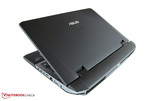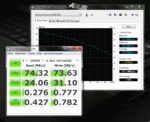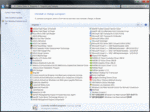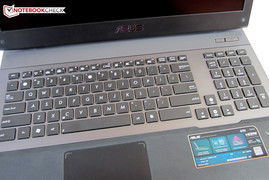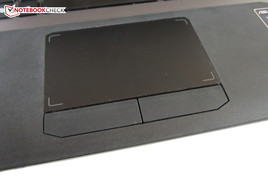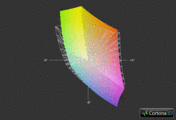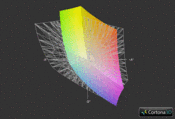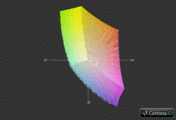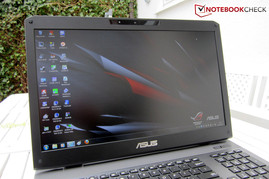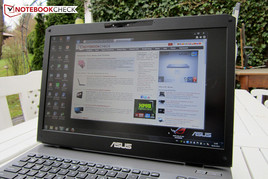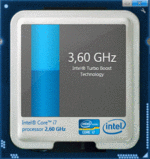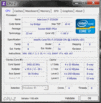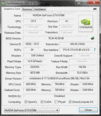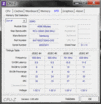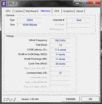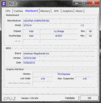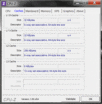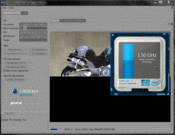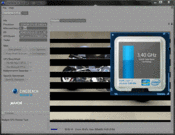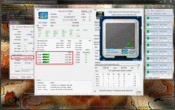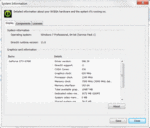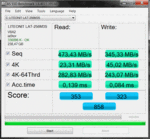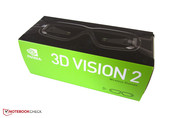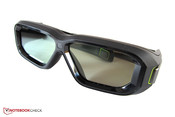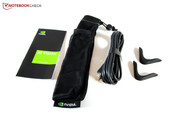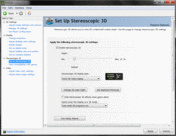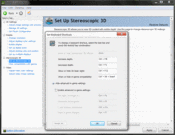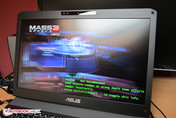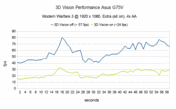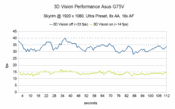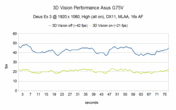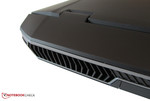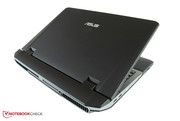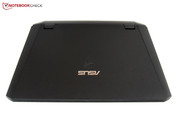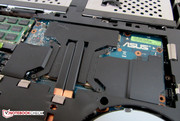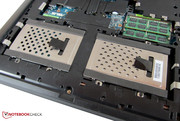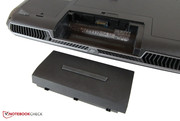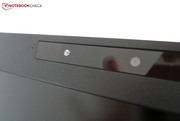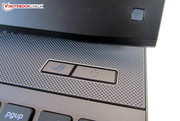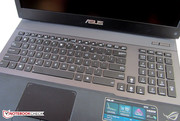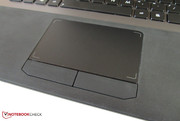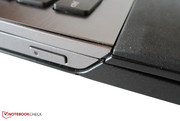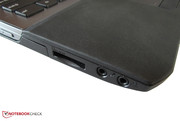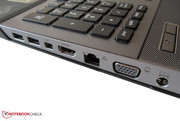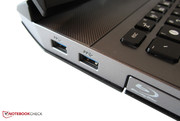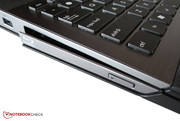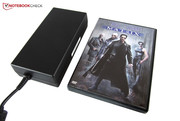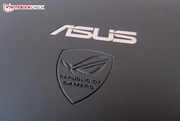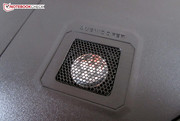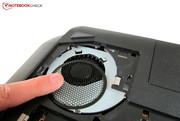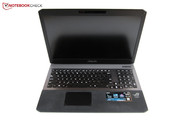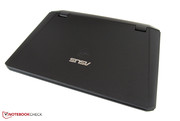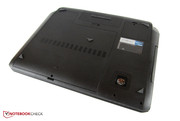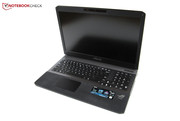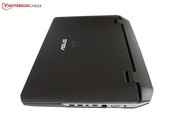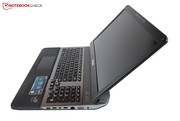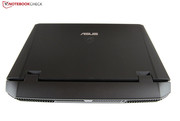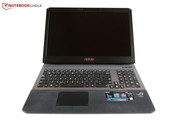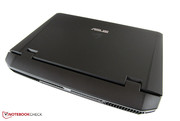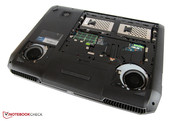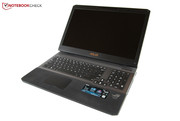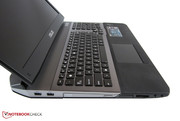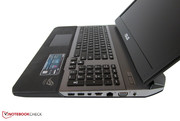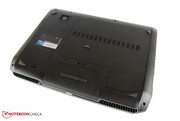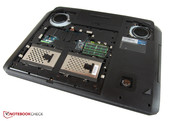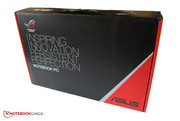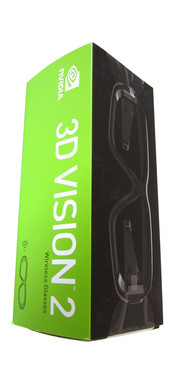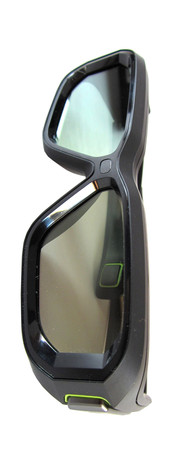Review Asus G75V Notebook
We take a look at the hottest new gaming laptop, the 17 inch Asus G75V, weeks before the official launch of the highly anticipated Ivy Bridge generation. Our test system is a hand-finished pre-production model and should closely resemble the shipping product. Of course, it's always possible that the manufacturer will change a few details before the release (fan control, software, etc) - but that shouldn't have a major impact on our review.
In comparison to the old G74, the new model has seen significant external and internal updates. Let's start with the graphics card: instead of the GeForce GTX 560M, the G75 uses the much faster GeForce GTX 670M. This high-end graphics card does not use Nvidia's new Kepler architecture, but the performance increase is still significant. According to our sources, there will be models with the slower (but Kepler-based) GeForce GTX 660M.
The processor has also been upgraded. The G74SX employed a member of the Sandy Bridge family (like the Core i7-2630QM), whereas the G75V uses a new Ivy Bridge CPU. The Ivy-based Core i7-3720QM is one of the fastest mobile processors in the world (2.6 GHz/3.6 GHz max turbo). The installed 16 GB DDR3 RAM (4x4GB) is an indication of the machine's high performance target.
The secret highlight of the G75V is the 3D-ready 120 Hz display (includes Nvidia 3D Vision 2). The notebook lives up to its premium standard and offers a Blu-ray burner and a 256 GB solid-state drive plus 750 GB hard drive. The operating system is Windows 7 Professional 64-bit.
In the coming weeks, the configurations available in Europe (and most importantly Germany) will be announced.
Case
The G75 resembles its predecessor quite a lot on the outside. The dark-grey surfaces of the top of the notebook are made of resistant rubber which can only be dirtied by greasy fingers.
The first significant difference is found on the back of the laptop. The manufacturer has moved the cooling vent (placed near the middle in the G74) outwards once again (see G73). More differences are found on the right and left side of the test model: instead of keeping a dark tone on the entire case, Asus has used a nice silver-grey streak to freshen up the look of the case.
Asus has given the G75 an amazing design which jumps at the eye as soon as the laptop is opened: the sides of the notebook as well as the speakers and the keyboard base are a stylish silver (aluminum). The palm rests, which use slightly rougher rubber than the top of the laptop, are also dark-grey.
Our review sample is a hand-finished pre-production model and as such we can not comment on the workmanship of the final product. Overall, we believe that the buyer can expect quality similar to the G74. We can provide detailed comparisons once we get our hands on the finished product.
Let us take a look at the sturdiness, which was a strong point of the G74 and G73. The top and bottom of the laptop only bend under significant pressure, and the display cover can be pushed inwards modestly. Two hands can bend the display significantly. While we are on the screen: the opening angle of 130° is not very accommodating.
The hinges left us with mixed feelings. On the one hand, the base stays still while the laptop is opened, but, the monitor shakes when the base is moved slightly (this applies to almost every notebook).
The 17" G75 is 52 mm thick and weighs around 4.4 kilograms. It's heavy and large but its measurements are, at least, smaller than those of its predecessor.
Connectivity
Ports
The Asus G75 has improved connectivity. The laptop still lacks eSATA and FireWire but the user will be surprised to find a mini DisplayPort added next to the VGA and HDMI interfaces. The USB ports have also been upgraded: the laptop has a total of four USB 3.0 ports (G74: 3x USB 2.0, 1x USB 3.0).
Most ports have merely been moved. The Kensington lock has been placed on the back and the card reader has moved from the right side to the left. The other ports (power interface, RJ-45 Gigabit LAN, headphone and microphone jacks) are almost identical. Two audio jacks are quite meager and we expect more from such a high-end notebook. Users looking to connect their Surround Sound systems will need to use the HDMI interface.
Of course, one could always complain about the placement of the ports. As the back of the laptop is occupied by the heat vents, Asus had no choice but to use the right and left sides of the test model. Advantage: all ports are close at hand. Disadvantage: right-handed users, who connect too many cables to the laptop, will be annoyed by the lmited space for using an external mouse while playing games.
Wireless Communication
The Qualcomm wireless module is dubbed the Atheros AR9485WB-EG. The PCIe card (2.4 GHz) supports the usual WLAN standards (802.11 b/g/n) and has a peak speed of 150 Mbps. Bluetooth 3.0 is also on-board.
Maintenance
The maintenance possibilities of the notebook have also been improved. Although the graphics card and processor still cannot be removed, we are delighted to see that the user can at least access the fan from above to clean it - previous models did not offer this freedom. The hard disk and a part of the RAM are also accessible under the maintenance flap (both secured with one screw).
Still, other machines do give the user more freedom. Barebones from Clevo (Schenker XMG P702) and MSI (One M73-2N) should set an example for Asus.
Software
Users who have previously owned an Asus notebook will not be surprised by the bundled junkware. Asus laptops have 60 different programs, updates and drivers pre-installed. We recommend throwing the unnecessary software out so as to increase the boot time and decrease the number of pop-ups. Special video modes (Splendid-Technology) and power-saving plans (Power4Gear) are just a gimmick.
Accessories
As the box at the bottom of our package was empty, we assume that the finished laptop will be delivered with additional accessories. The packet lacked a driver disc and a manual, but it did include Nvidia's 3D Vision 2 (more about this later), the 74 Wh battery, and the 180 W power adapter. The user will have to burn his own recovery disc for system restoration.
Input Devices
Keyboard
The integrated keyboard is the same as the G74's. The freely placed keys measure 15x15 mm. They have a comfortably quiet click and a decent pressure point (the stroke could have been stronger).
The English keyboard has a fine layout, although the divided Paste/Delete key may cause problems. The displaced cursor keys present a nice gap between the main keyboard and the numeric pad.
Asus deserves praise for the white lighting which can be adjusted (many levels) with a Fn key combination. Asus should tweak the lighting further as some keys are brighter than others (see picture). Clevo's P150EM and P170EM barebones (Schenker XMG P502 & P702 respectively) have more balanced lighting.
Touchpad
The large Synaptics touchpad (99 x 56 mm) is ideal and should be considered by other manufacturers. The smooth surface has great gliding properties – cursor movements are very easy. Despite the fact that it is the same color as the rest of the hand-rest regions, the touchpad can be clearly felt as it is sunken into the case and has smooth haptic response.
Although the precision of the device is good, the supported gestures (multi-touch) are finicky. For example, while scrolling on a webpage or text document, the computer jumps uncontrollably upward or downward. Sometimes the scrolling does not work at all. We still like the touchpad and the comfortable mouse keys helped us make our decision. Tip: the touchpad is configured to deactivate as soon as an external mouse is connected.
Display
Great: the test model has the same Full HD panel which was used in the 3D version of the G74SX (LGD02C5). The display has a resolution of 1920x1080 pixels (ideal for high-end laptops), which gives the user enough room to work comfortably. The matte display is high-quality as can be seen from the direct comparison with an 08/15 panel (see picture) which reveals the significant differences between the two.
| |||||||||||||||||||||||||
Brightness Distribution: 90 %
Center on Battery: 436 cd/m²
Contrast: 715:1 (Black: 0.61 cd/m²)
65.8% AdobeRGB 1998 (Argyll 3D)
89.7% sRGB (Argyll 3D)
69.7% Display P3 (Argyll 3D)
The decent black value of 0.6 cd/m² indicates that the display can present a more satisfying black than most notebook displays. The colors are very strong and even the majority of the glossy competition can not hold their own.
The panel has amazing values: 421 cd/m² is twice the brightness of a standard notebook panel (~200 cd/m²). The contrast value of 715:1 is without a doubt amazing. Thanks to the 120 Hz support, the display can portray 3D content beautifully.
The good horizontal viewing angle is another strength of the panel. Even with multiple viewers, everyone gets a good picture, which means that a family movie night or watching videos with friends is not a problem with the G75. Small disadvantage: the display can not be turned too far back as (typical to notebooks) the vertical viewing angle is pretty narrow. Overall, the G75 scores high in this section.
Performance
Processor
We have been waiting a long time for Ivy Bridge. The latest Intel generation is not ground-breaking, but the new CPUs do use a smaller 22 nm manufacturing process and unique 3D transistors. Intel considers the new model to be "Tick+" ("Tock" would be a completely new architecture).
The die has seen a commensurate shrink from 216 mm² down to 160 - meaning Ivy Bridge is not only faster than Sandy (especially in graphics - see our HD Graphics 4000 benchmark), but smaller as well.
Asus has installed a Core i7-3720QM in our test model - a very powerful quad-core CPU. The processor commands 1.4 billion transistors (Sandy Bridge: maximum 995 million). The clock frequency ranges between 2.6-3.6 GHz under load which places the quad-core processor between the older high-end models: the i7-2920XM (2.5-3.5 GHz) and the i7-2960XM (2.7-3.7 GHz). Great: despite similar performance, the TDP has dropped from 55 W to 45 W. The Core i7-3720QM has a smaller L3 cache in comparison to the Sandy Bridge elite (6 MB vs. 8 MB), but this is not noticeable in the performance benchmarks.
Most features are known from the previous generation. Turbo Boost overclocks the processor automatically and Hyper-Threading allows each core to handle two threads - theoretically doubling the number of available cores. Asus does not offer graphics switching (due to 3D, Optimus is not possible), and this means that the new HD Graphics 4000 remains inactive.
Turbo Boost
The clock frequency of the Core i7-3720QM rises significantly using Turbo Boost - as long as the processor stays acceptably cool. For example: in Cinebench R10, the quad-core ran between 3.4 GHz (multi-core rendering) and 3.6 GHz (single-core rendering). An amazing performance - most CPUs can only dream of such high speeds.
Performance in the stress test was less attractive (Furmark & Prime). Although the CPU never reached critical temperatures, it did have to clock itself down to 1.2 GHz to maintain acceptable thermals. Still, the throttling of the G74SX was much more critical - 800 MHz.
During normal (gaming) use, the laptop delivers sufficient performance. All benchmarks ran without a hitch.
Throttling is a problem in other notebooks as well (see the Medion Erazer X7813).
CPU Performance
As expected, the Core i7-3720QM offers amazing performance: 6.8 points in Cinebench R11.5. The score beats the Core i7-2630QM of the G74SX by about 40% (4.83 points). Top models like the Core i7-2920XM (6.19 points @ One M73-2N) and Core i7-2960XM (6.33 points @ Schenker XMG P701 PRO) do not stand a chance against their new brother. 6.8 points places the processor at the same level as the extremely fast desktop processor: Core i7-2600k (3.4-3.8 GHz). However, the i7-2600k has nearly double the TDP (95 watts).
In short: Ivy Bridge deserves praise - it's a worthy upgrade, and offers substantial energy improvements as well. More CPU benchmarks can be found in our list (for example, SuperPI, WinRAR and TrueCrypt).
Graphics card
Asus has picked one of the fastest graphics cards currently available. The GeForce GTX 670M is based on the GF114 (Fermi architecture) - essentially a rebrand of the GTX 570M. Nvidia's promising that future 600-series mobile chips like the GeForce GTX 660M and (according to rumors) the GTX 680M will use the Kepler architecture. These high-end graphic cards are yet to be released.
In comparison to the GTX 670M, the GTX 675M is 20% faster. The 670M is clocked at a lower speed: the 675M runs at 620/1240/1500 MHz (core/shader/memory) whereas our graphics card runs at 598/1196/1500 MHz (the tools show false values). Other differences include the smaller number of shaders (336 vs. 384 CUDA cores) and the narrower memory interface (192 vs. 256 bit). Notably, Asus uses a model with 3 GB GDDR5 VRAM (1536 MB @ One M73-2N).
The long features list is Nvidia's trademark. Gamers will definitely be happy with the PhyX support which can be activated to display additional physical effects in games at a moderate performance cost.
GPU Performance
Our G75 beats the old G74SX by miles in the graphic benchmarks. In the Unigine Heaven benchmark, the GTX 670M takes the lead by 42% vs the GTX 560M: 38.9 vs 27.3 fps at 1280x1024. The main competition from AMD, the Radeon HD 6990M, delivers 36.6 fps which is still lower than the graphic card of our test model (Schenker XMG P701 PRO). The GTX 675M takes a lead of 21% (47.2 fps @ Schenker XMG P702 PRO).
In 3DMark 11 (1280x720 pixels), the situation changes slightly. The GTX 670M scores 2,684 points and is beaten by its bigger brother (GTX 675M - 3,272 points) and the AMD competition (Radeon HD 6990M - 3,227 points). The GTX 560M reaches a mere 1,836 points (-32%).
| 3DMark 03 Standard | 49522 points | |
| 3DMark 05 Standard | 28830 points | |
| 3DMark 06 Standard Score | 20458 points | |
| 3DMark Vantage P Result | 12728 points | |
| 3DMark 11 Performance | 2989 points | |
Help | ||
Storage
Which manufacturer jumps to mind when you think of SSDs? Intel, Samsung, OCZ, or maybe Crucial? The G75 responds with Lite-On. The test model uses a 256 GB Solid State Drive (LAT-256M3S).
This was not a bad decision as is apparent from the drive's benchmark scores: the sequential read rate of 473 MB/s and sequential write rate of 345 MB/s (AS SSD benchmark) places the SSD right next to other high-end models such as the Samsung SSD 830 (504 & 314 MB/s @ Schenker XMG P702 PRO). In fact, the Lite-On drive can even perform faster in some tests. The access times of 0.14 ms (read) and 0.08 ms (write) are close to those of the Samsung SSD.
Is 256 GB not enough? No problem, because in addition to the SSD, the Asus G75 is also equipped with a 750 GB Seagate Momentus 7200.5 (ST9750420AS). As the name indicates, the drive runs at 7200 rpm. It has an access time of 15.1 ms (HDTune) and a sequential transfer rate of around 120 MB/s (CrystalDiskMark) - very good for a 2.5" HDD.
System Performance
The system performance lives up to the motto: "No Half-Measures". We have tested faster notebooks, but none have reached more than 20,500 points in PCMark Vantage. Gaming notebooks without a SSD stay under 10,000 points. Worthy of mention: 5,262 points in PCMark 7. The G75 offers great performance - regardless whether it is running demanding 3D programs or everyday applications.
| PCMark Vantage Result | 20517 points | |
| PCMark 7 Score | 5262 points | |
Help | ||
Gaming Performance
Users willing to sacrifice Anti-Aliasing or maximum details now and then will be very satisfied with the GeForce GTX 670M. With the exception of some extreme cases, such as Alan Wake or Metro 2033, it performs very well at high settings.
The old G74 reached its limits much faster when running the latest games. Overall, the GTX 670M cruises ahead of the GTX 560M by around 30%. The current elite (Radeon HD 6990M and GeForce GTX 675M - both about 20% faster) beats the GTX 670M easily.
Passionate gamers should pick a faster notebook or wait for the release of the GeForce GTX 680M/Radeon HD 7970M. The AMD model should be an amazing price-to-performance hit (according to our sources). We will stay on alert.
| low | med. | high | ultra | |
|---|---|---|---|---|
| Metro 2033 (2010) | 41.2 | 14.1 | ||
| StarCraft 2 (2010) | 89.2 | 49.3 | ||
| Mafia 2 (2010) | 91.3 | 56.1 | ||
| Call of Duty: Black Ops (2010) | 118.5 | 82 | ||
| Crysis 2 (2011) | 82.7 | 29.1 | ||
| Dirt 3 (2011) | 100 | 35.6 | ||
| Deus Ex Human Revolution (2011) | 112.7 | 42.2 | ||
| F1 2011 (2011) | 95 | 39 | ||
| Fifa 12 (2011) | 275.3 | 170.7 | ||
| Batman: Arkham City (2011) | 157 | 138 | 68 | 29 |
| Battlefield 3 (2011) | 47.5 | 19.7 | ||
| CoD: Modern Warfare 3 (2011) | 91.8 | 57.1 | ||
| The Elder Scrolls V: Skyrim (2011) | 59.1 | 33.1 | ||
| Anno 2070 (2011) | 55.4 | 27.5 | ||
| Alan Wake (2012) | 47.8 | 21.7 | ||
| Mass Effect 3 (2012) | 60 | 53 |
3D Vision 2
Technology and Delivery
One of the most important features of the G75 is the optional 3D display. As mentioned before, the display supports 120 Hz and can use Nvidia's 3D Vision to display 3D content. Nvidia's 3D Vision has been around a while and has matured into its second version. The functionality has not changed from when we tested it, so we will only discuss the basic technology of 3D Vision and the minor changes in 3D Vision 2.
3D Vision uses the so-called shutter method. This method requires a sensor (integrated in the display), a suitable monitor (supporting 120 Hz) and shutter glasses. The shutter method combines the two half pictures displayed on the panel so fast that the human eye witnesses a 3D effect. Without the glasses, the user can only see a slightly bloated picture.
In comparison to the first generation, Nvidia 3D Vision 2 offers improved shutter glasses (57 grams). The new glasses are bigger and more comfortable to wear. Although 3D Vision is not optimized for people already wearing glasses, the new shutter glasses do lie more snugly on the nose.
The integrated battery (which can be charged using a USB cable) provides power to the glasses and can hold a charge for multiple days of 3D use. The 3D Vision box holds a short manual, a small bag and two swappable nose pieces.
Configuration and Drivers
Ideal: our test model had active 3D Vision from the start. In the "Stereoscopic-3D" menu of the nVidia control panel, a variety of options allow the user to configure 3D Vision: for example, adjust the depth or set the shortcut key.
A compatibility list informs the user how a game performs with 3D Vision. Although Nvidia does not recommend the use of 3D Vision in some games, other games (such as Battlefield 3) boast a "3D Vision Ready“ logo. This insignia guarantees flawless 3D portrayal of the game (the games were optimized for 3D).
Practical use
The user puts on the 3D Vision glasses and starts the desired game. The level of configuration for 3D Vision varies from game to game. The tips which pop up help notify the user about potential problems caused by activating a feature. Manual optimization of the graphic card makes 3D Vision a delight.
The drop in brightness (caused by the dark glasses) is made up for by the high brightness of the monitor.
Performance
The biggest drawback of 3D Vision is the high performance penalty. The three games we tested (see graphs) had average fps drops up to 60%. The user will have to sometimes lower the resolution or detail level so as to get fluid gameplay. A resolution of 1920x1080 pixels and high settings will cause many games to stutter.
We have listed the pros and cons of 3D Vision to help the reader make an informed purchase.
Pros
- beautiful picture, as the resolution is not halved or otherwise reduced
- the latest shutter glasses are quite comfortable to wear
- various options and configuration possibilities
- at times the 3D effect is amazing
- low viewing angle dependance
- works perfectly most of the time
- extensive game support
- helpful tips
Cons
- sometimes the picture is unclear in the front or back (may be due to the user/program)
- a few artifacts and ghost images (can be due to user/program)
- waiting times due to loading (3D Vision needs to configure first)
- adjustments in the graphics menu are necessary
- drop in brightness
The technology is suited for 3D pictures and 3D films as well. A "Photo Viewer" is pre-installed and allows the user to view 3D pictures. On the other hand, the "3D Vision Video Player" necessary for 3D film playback had to be downloaded (we recommend the use of the free "Stereoscopic Player" from 3dtv.at). The offering of 3D Blu-rays has risen significantly. Nvidia also presents their 3D homepage: 3dvisionlive.com. This site hosts a variety of media for testing purposes.
Conclusion
If a pair of glasses (additional) are fine with you, then you should be able to have fun with 3D Vision. Unfortunately, high performance cost will push the GTX 670M to its limits.
Emissions
Noise
The Asus high-end notebooks (since G73) are relatively quiet. The latest addition to the family maintains that high standard even in 3D mode. The two fans run at an acceptable level. A lot of the competition gets louder under full load: the industry average is between 40 and 50 dB(A). The noise will only rise if the G75 is at 100% load (Furmark & Prime).
While idle, the G75 test model revealed some quirks. The notebook was quiet at the start of the test: both fans were often off and the only emissions came from the hard disk (31-33 dB). During testing, the GPU fan (33-35 dB) rarely switched off (suddenly with minimal clattering) - the noise reached an audible level. This oddity is probably due to the precursor state of our model.
Still, most competing laptops are much louder than the G75.
Noise level
| Idle |
| 33.2 / 34 / 34.6 dB(A) |
| DVD |
| 36 / dB(A) |
| Load |
| 36.9 / 41 dB(A) |
 | ||
30 dB silent 40 dB(A) audible 50 dB(A) loud |
||
min: | ||
Temperatures
The low temps are a great plus. The chassis stays at 26°C on average while idle. Even under load, the hand-rest regions do not heat up too much - only around 30°C.
Let us take a look inside the laptop: the Core i7-3720QM clocks down to 1.2 GHz at full load although the CPU always remains in the green. The graphics card reaches a maximum of 74°C - not bad. In short: Asus manages to deliver a great cooling system.
(+) The maximum temperature on the upper side is 33.8 °C / 93 F, compared to the average of 40.5 °C / 105 F, ranging from 21.2 to 68.8 °C for the class Gaming.
(+) The bottom heats up to a maximum of 36.1 °C / 97 F, compared to the average of 43.3 °C / 110 F
(+) In idle usage, the average temperature for the upper side is 25.6 °C / 78 F, compared to the device average of 33.9 °C / 93 F.
(+) The palmrests and touchpad are cooler than skin temperature with a maximum of 28.6 °C / 83.5 F and are therefore cool to the touch.
(±) The average temperature of the palmrest area of similar devices was 28.9 °C / 84 F (+0.3 °C / 0.5 F).
Speakers
After a long time spent trying to configure the speakers of the test model, we came to the conclusion that our sound system had a few bugs. We contacted Asus and they told us that it was probably due to the driver of our review model.
The subwoofer only works when we set the speakers to "2.1 channels" in "VIA HD Audio Deck" (advanced mode). Sadly, with this setting, the subwoofer delivered the bass and all the other tones as well. Result: playback heavily based on the left side.
In addition, the volume is quite high even with low settings. This issue could be somewhat corrected when we dropped the volume of the subwoofer (via "Audio Deck"). A little tuning made the sound output of the G75 really good but it could not reach the level of the Toshiba Qosmio X770 or the MSI GT70.
Asus should check the audio software of the laptop and remove any bugs. We will test the finished model again when it is launched.
Battery Life
The 17-inch G75 lacks switchable graphics (due to incompatibility with 3D Vision) which means that it consumes a lot of power even while idle. The power consumption lies at 30-43 W - slightly above the weaker G74SX (27-37 W). Optimus laptops like the Schenker XMG P702 PRO (14-29 W) or the One M73-2N (10-19 W) smile at these values. 3D applications boost the power consumption and the competition has similar values under load. In 3DMark 06 the laptop required 127 W and in the stress test it consumed a maximum of 170 W.
| Off / Standby | |
| Idle | |
| Load |
|
Key:
min: | |
Disappointingly, the G75 only lasts about 2.5 hours, even idling at minimum brightness (Readers test from Battery Eater).
It lasted about 2 hours while surfing on the web (medium brightness) and a meager 1.5 hours while playing a movie (maximum brightness). In the Classic Test from Battery Eater, the laptop lasted a mere hour. As the G75 is designed to be a DTR, we believe that the battery life should not affect its use much.
Playing on the G75 while it is running on battery is not recommended as the three games we tested (Modern Warfare 3, F1 2011 & Anno 2070) all had massive frame rate drops.
Verdict
The G75 corrects many of the G74's shortcomings. Asus hasn't fixed everything (like the middling connectivity), but three video interfaces and four USB 3.0 ports compensate somewhat for the lack of eSATA and Firewire.
The modified case seems more compact and the silver keyboard base contrasts nicely with the rubber surfaces of the laptop. The fan is somewhat accessible now but the maintenance possibilities are nowhere near those of Clevo and MSI models.
The G75 has also inherited the strengths of the series. For example, it's relatively quiet. In contrast to many competitors, the G75 does not become too loud or too hot under load. The generous touchpad and lighted keyboard make the laptop even more attractive.
We also get great hardware and great performance: 16 GB DDR3 RAM, a Blu Ray burner, a Solid State Drive, a quad-core Ivy Bridge CPU, and a high-end graphics card - this model is a dream for gamers and entertainment fans.
Thankfully, Asus has not neglected picture quality. The matte panel supports 120 Hz and outperforms the competition: high brightness, great contrast, and satisfying colors. In addition, thanks to the 120 Hz support and Nvidia's 3D Vision technology, the display provides an intense game experience (Be careful: in 3D mode, frame rates drop by roughly half).
It is a pity that due to the 3D technology, the laptop can not use graphics switching - 1-2 hours of normal use is poor, even for a DTR. At 4.4 kg, the G75 is also on the heavy side.
Overall, we can't complain. Asus has done a fine job and made the G75 a great DTR. Despite a few flaws, the test model walks away with a rating of 88%.





